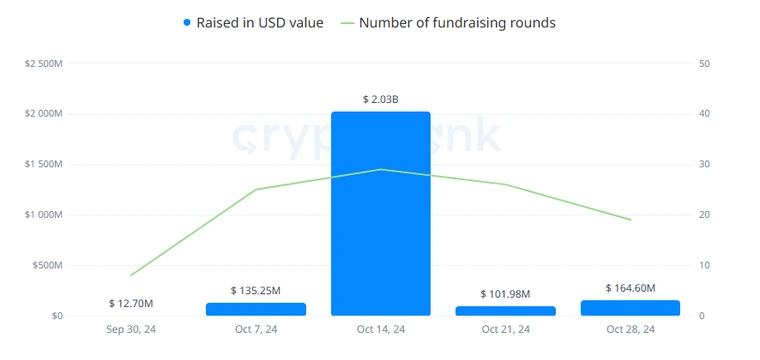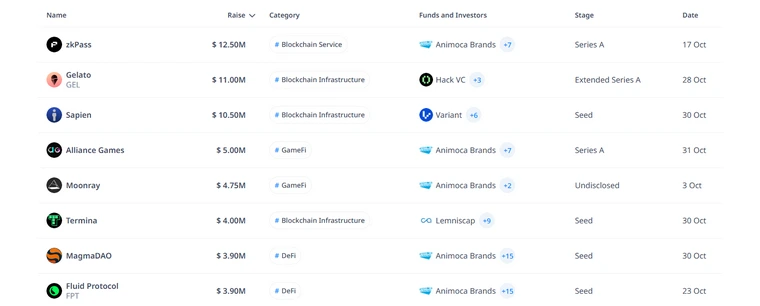October Fundraising: Analyzing VC Activity

While much of the market waits in near-hibernation for the next bull run, venture capitalists are staying active, investing in diverse projects and shaping the future of industry solutions.
The anticipated crypto rally in October seems to have materialized: BTC nearly reached its all-time high, and some altcoins doubled in value, signaling a partial recovery in user interest.


The "Uptober" momentum extended to fundraising as well, with crypto projects securing $2.45 billion last month.
For comparison, the September total was just over $600 million.
In this report, we’ll examine:
- the projects that attracted the most investment in October;
- the sectors most appealing to investors;
- the funds that were the most active during this period.
Top Categories: Most Popular Niches Among VC Investors
Notably, the second week of October saw peak VC activity, with $2.03 billion invested during this period.

Fundraising Distribution by Week in October. Source: cryptorank.io
The leading category in October was "Blockchain Services," with projects in this niche raising $1.24 billion.
For comparison, this category attracted only $145 million last month—nearly ten times less.
The remaining funds were distributed as follows:
- Social Media Platforms — $578 million. Web3 projects focused on social engagement, mainly social media platforms, but also other products such as identity protocols.
- Blockchain Infrastructure — $265 million. Solutions that improve the user experience when interacting with different blockchains.
- DeFi — $143 million. Decentralized finance projects combining blockchain technology with users' financial needs.
- GameFi — $102 million. Projects developing games and other entertainment activities, including Tap-to-Earn, Move-to-Earn, and other X-to-Earn applications.
- Blockchains — $80 million. Projects focused on developing and maintaining blockchain networks, including L1 networks like Solana and Ethereum, and L2/L3 solutions like Arbitrum and Xai.
- CeFi — $33 million. Similar to DeFi, CeFi projects integrate finance and blockchain but operate through centralized platforms, such as cryptocurrency exchanges.
To appreciate the growth of these categories, it’s essential to examine their trends over time. October’s numbers become more meaningful when compared to last month’s VC investments.
In October, blockchain services saw a tenfold increase in funding compared to September. Other niches showed similar trends: investment in Web3 social networks grew tenfold, blockchain infrastructure by 18 times, CeFi by 1.8 times, and GameFi by 1.2 times.
It's also important to mention the categories where fundraising declined: DeFi (down 17%) and blockchains (down 52%).
Investment Distribution by Round Size
In October, venture funds conducted a total of 108 funding rounds, with only 83 of these publicly disclosing their amounts. The rest remained undisclosed.
Funding distribution was notably uneven, with some VC funds making smaller investments while others made significantly larger contributions. This distribution reflects varying investment strategies, ranging from “many small bets” to “concentrated investments.”
Here’s the breakdown of funding rounds by size in October:
- Over $50 million — 3 rounds
- $20–$50 million — 6 rounds
- $10–$20 million — 10 rounds
- $3–$10 million — 37 rounds
- $1–$3 million — 24 rounds
- Under $1 million — 3 rounds
Now, let’s compare these numbers with those from the previous month.
In September, there were no rounds above $50 million, while October saw three. This shift indicates an uptick in interest from larger investors. Below, we’ll provide a closer look at each of these major rounds.
As in the previous month, most rounds in October fell within the $3–$10 million range. Typically, these investments are made by Tier 3 funds, which adopt a “spread and diversify” approach, funding numerous projects in the hope that at least 10% will succeed.
This suggests that investors aren’t yet focused on any specific direction. However, once we start seeing a shift towards larger rounds, predicting future trends will become easier.
We also consider the average funding round size in fundraising analysis. For October, this figure rose to $29.5 million, up from $9.5 million in September, signaling a growing interest from VCs in crypto projects.
Top VC Funds by Activity in October
The most active VC fund in October was Animoca Brands—a Tier 3 fund specializing in NFT investments, with more than 23% of its funding rounds focused on the non-fungible token sector.
In October, Animoca Brands allocated $55.5 million to various crypto projects, including zkPass ($12.5 million), Gelato ($11 million), and Sapien ($10.5 million).

List of Projects Funded by Animoca Brands in October. Source: cryptorank.io
CMS Holdings ranked second among the most active VCs—a Tier 2 fund primarily focused on Bitcoin ecosystem projects.
In October, CMS Holdings participated in seven funding rounds, investing a total of $21.9 million across projects such as Drop Protocol ($4 million), MagmaDAO ($3.9 million), and Fluid Protocol ($3.9 million). Notably, Animoca Brands also participated in the latter two rounds.
Andreessen Horowitz (a16z) came in third in terms of funding activity—a Tier 1 fund known for its investments in AI and crypto projects.
In October, a16z participated in seven rounds, investing a total of $73.7 million in projects like Azra Games ($42.7 million), Opacity Network ($12 million), and OpenGradient ($8.5 million).
Stripe Acquires Stablecoin Platform Bridge for $1.1 Billion
On October 20, 2024, it was announced that payment processing giant Stripe is acquiring Bridge, a platform providing infrastructure for supporting and managing stablecoins. This acquisition is the largest to date for both Stripe and the crypto industry as a whole.
Stripe CEO Patrick Collison confirmed the deal:
In March, Stripe reported that its total processed payments exceeded $1 trillion in 2023. Businesses utilizing Stripe’s infrastructure represent around 1% of global GDP, with high-profile clients such as tech giant SpaceX.
The acquisition follows an announcement six months earlier by Stripe co-founder John Collison, who stated that the company would begin supporting stablecoin payments by summer 2024. Stripe has since integrated support for Circle’s USDC, but the purchase of Bridge signals that this is just the beginning.
In August, Bridge raised $40 million in a Series A funding round from Sequoia, Ribbit Capital, Index, and Haun Ventures.
Notably, Bridge does not develop or issue new stablecoins. Instead, it provides infrastructure for client organizations to create, store, send, and receive stablecoins.
As of the time of writing, further details about the acquisition remain undisclosed.
Praxis Society Raises $545 Million to Build a Utopian City
On October 15, Praxis Society—a project focused on creating utopian cities for crypto enthusiasts—announced it had raised $545 million to build its next visionary city. This concept is familiar to the market, with past attempts including Akon City and Satoshi Island.
The funding round for Praxis Society attracted both individual angel investors, such as Dan Romero and Paul Taylor, and VC funds such as Manifold and GEM Digital. GEM Digital made the largest contribution, investing a remarkable $525 million.
Following the project’s launch, Praxis Society plans to introduce its own token, which will grant holders rights to participate in future real estate development, land purchases, housing, and other opportunities within the city.
The project promises a city that lowers regulatory barriers for tech companies in fields such as AI, cryptocurrency, biotech, energy, and advanced manufacturing.
Praxis envisions creating a "heroic and beautiful lifestyle" by fostering culture and institutions within the city. The team is also determined to demonstrate that such an ambitious project can be achieved in the 21st century.
According to the project, architects have already developed a city design concept that combines futuristic and classical aesthetics with scalable urban planning.
The location of this tech utopia is still unknown, though rumors suggest it may be built somewhere in Latin America or the Mediterranean.
Blockstream Raises $210 Million
On October 15, 2024, Blockstream—a company specializing in Bitcoin infrastructure—announced it had raised $210 million in a funding round led by Tier 4 venture fund Fulgur Ventures.
Blockstream stated that the funds will go toward developing its own L2 network, expanding BTC mining operations, and increasing the company’s Bitcoin reserves. The focus will be on advancing projects like Liquid and Lightning.
Founded by renowned Bitcoin developer Adam Back, Blockstream is one of the pioneering companies dedicated to building infrastructure for Bitcoin.
Why Analyze Crypto Fundraising?
Knowing the details of a project’s fundraising efforts makes it easier to track who is backing it, how much funding it has received, and how those funds are managed. This insight can reveal weaknesses within the project and help gauge the realism of the team’s promises.
Fundraising analysis also helps identify emerging trends.
For instance, increased interest from major investors in DeFi, NFT, or AI projects can signal the rise of new narratives in these sectors. By spotting these trends early, you gain a competitive advantage over other market participants.
While you can conduct this analysis on your own by reviewing reports, tracking token data, and monitoring holders, it requires time, skills, and a grasp of subtle nuances. For quicker insights, subscribe to the GNcrypto Telegram channel to be among the first to receive reports on the current state and future potential of crypto projects.
Recommended


